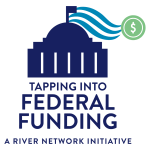Investing in Access to Clean and Safe Water Through the State Revolving Loan Funds
The passage of the Infrastructure Investment and Jobs Act (IIJA) last fall – or what is now known as the Bipartisan Infrastructure Law (BIL) – has been celebrated by advocates across the country for its historic investment in water infrastructure. Most of this investment flows through the State Revolving Loan Fund Program (SRFs) – the largest source of federal funding for water infrastructure. An additional nearly $50 billion has been added to the Clean Water and Drinking Water SRFs (CWSRF & DWSRF) over the next five years, including funding for lead service line replacement projects and addressing emerging contaminants of concern, such as PFAS. Additionally, 49% of these funds must be provided to disadvantaged communities (DACs) – communities that are in greater need of additional investment in their water infrastructure – in the form of grants or zero-interest loans. This greatly reduces the burden of repayment that communities often face when acquiring SRF loan funding.
What are the SRFs and why are so many groups focused on these funds?
The Clean Water and Drinking Water State Revolving Funds (CWSRF & DWSRF) are two federal funding programs that provide grants to states to support water infrastructure maintenance and upgrades throughout the country. The CWSRF provides critical funding for infrastructure projects that protect water quality, promote climate resilience and ensure compliance with the Clean Water Act, while the DWSRF funds drinking water infrastructure projects that ensure water systems maintain compliance with Safe Drinking Water Act standards and provide clean and safe drinking water to customers.
While both of these programs are longstanding and essential, they have not always delivered impact to the communities most in need of infrastructure investment. With the additional IIJA funding over the next five years, there is a distinct emphasis on ensuring these dollars reach those communities that need it most. The large influx of dollars and the many provisions to support equitable implementation mean that there is a large role for advocates to play in ensuring their states and local water systems take advantage of this historic moment to invest in their community’s water infrastructure.
River Network’s Approach
River Network has been supporting groups working on water infrastructure since the release of our Equitable Water Infrastructure Toolkit in 2021, and continues to support water protectors as they navigate this new funding landscape for water infrastructure. By providing accessible resources and trainings, River Network aims to ensure water protectors across our network are able to meet this historic moment. Below is a list of resources, including toolkits, recordings and slides that River Network has pulled together to support you in understanding and influencing equitable implementation of SRFs in your community.
- 3-part baseline training on The Fundamentals of SRF Administration & Influencing Equitable Infrastructure in Your Community. Access recordings and slides here.
- 2-part peer call on the Infrastructure Investment and Jobs Act with presentations from partners at NRDC, Earthjustice and American Rivers. Access recordings and slides here.
- SRF resource page, including EPA Regional Contacts for SRF Section Chiefs, accessible here.
- Blog post on all water funding provisions in the Infrastructure Investment and Jobs Act, accessible here.
In addition to these resources, River Network has partnered with Alliance for the Great Lakes, EPIC, and PolicyLink to host an online community and monthly calls for advocates working on SRF implementation. To join this this community, please reach out to me, Sheyda Esnaashari, Drinking Water Program Director.







[…] our blog to learn more about River Network’s SRF and LIHWAP work and learn more about the Clean Water Act Owner’s Manual […]